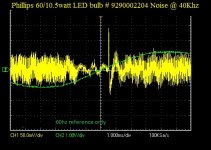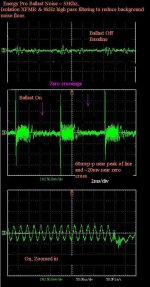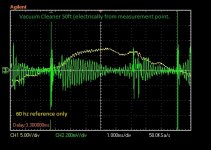gar
Senior Member
- Location
- Ann Arbor, Michigan
- Occupation
- EE
220102-1319 EST
An update.
When I previously said that I did not see a reduction in the unwanted signal until I pulled the main fuses was accurate. Except that when I just turned breakers off I did not turn off one breaker. So the statement was actually incorrect. Turning off all breakers does greatly reduce the noise level. So it isn't necessary to pull the main fuses to do my search for the noise sources, and the major source of unwanted signals is within my home.
I have now placed an RFI filter in the supply to some of the noise sources.
Looking directly at my 60 Hz supply with a 10X probe I have a very clean and nearly perfect sine wave. The deviation from a sine wave is near the peak and is distortion from all of the 10,000s of computer capacitor input power supplies that load the power system. You see this in the distortion of the sine wave peak. Back in the early 1960s when I made photos of the power system waveform I did not see that distortion.
To look at my present sine wave directly it looks extremely clean.
When I look at this same power line signal with the low frequencies greatly attenuated is when I see these unwanted millivolt signals on the power line. These are seen via capacitive or inductive coupling. There are many different sources that cause these unwanted signals.
I will discuss this further later.
.
An update.
When I previously said that I did not see a reduction in the unwanted signal until I pulled the main fuses was accurate. Except that when I just turned breakers off I did not turn off one breaker. So the statement was actually incorrect. Turning off all breakers does greatly reduce the noise level. So it isn't necessary to pull the main fuses to do my search for the noise sources, and the major source of unwanted signals is within my home.
I have now placed an RFI filter in the supply to some of the noise sources.
Looking directly at my 60 Hz supply with a 10X probe I have a very clean and nearly perfect sine wave. The deviation from a sine wave is near the peak and is distortion from all of the 10,000s of computer capacitor input power supplies that load the power system. You see this in the distortion of the sine wave peak. Back in the early 1960s when I made photos of the power system waveform I did not see that distortion.
To look at my present sine wave directly it looks extremely clean.
When I look at this same power line signal with the low frequencies greatly attenuated is when I see these unwanted millivolt signals on the power line. These are seen via capacitive or inductive coupling. There are many different sources that cause these unwanted signals.
I will discuss this further later.
.




